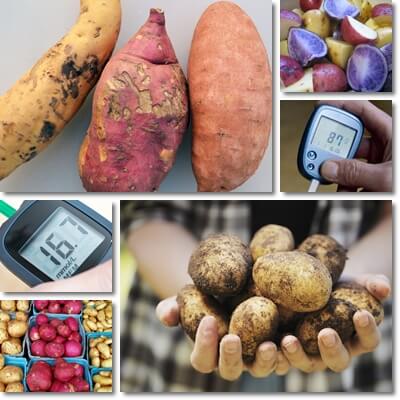Potatoes and diabetes don’t make the best of pairs primarily because most potato varieties have a moderately high to high glycemic index and glycemic load which means the carbohydrates in them are broken down into simple sugars quickly and raise blood sugar levels fast. The diabetic person, who is either insulin-deficient or insulin-resistant, cannot efficiently process high amounts of sugar present in the bloodstream at the same time. And the longer sugar from carbohydrates from food stays in the blood, the more likely the chances of diabetes-associated illness ranging from loss of vision to heart disease.
But can diabetics eat potatoes? They can, but in very small amounts, preferably infrequently, as part of an overall balanced and varied diet tailored to the individual nutritional requirements of the diabetic patient and the restrictions of their condition. Given their moderately high to high glycemic index and glycemic load score, the hyperglycemic effects of potatoes indicate the need to limit consumption to small amounts. Ideally, potatoes should not be eaten everyday, both to limit effects on blood sugar and to allow for variety in the diabetic person’s diet.

Potatoes average carbohydrate content. 100 g of raw potato, flesh and skin, provides 17.49 g of total carbohydrates of which 0.82 g are simple sugars and 2.1 g indigestible fiber.
One small raw tuber (estimated weight: 170 g) provides 29.73 g of total carbohydrates of which 139 g are simple sugars and 3.6 g indigestible fiber.
One medium raw tuber (estimated weight: 213 g) provides 37.25 g of total carbohydrates of which 1.75 g are simple sugars and 4.5 g indigestible fiber.
Both white and red potatoes have about the same nutritional value.
All digestible carbohydrates (except fiber) are broken down during digestion into their simplest form, sugar, which is then absorbed into the bloodstream and thus contributes to blood sugar (or glucose) levels. The more carbohydrates a food has, the more sugar you get from said food and the higher the rise in blood sugar levels. But diabetics are either insulin deficient or insulin resistant, meaning either the pancreas doesn’t produce enough of the hormone insulin or the body doesn’t respond correctly to it.
Insulin helps move sugar from the bloodstream to cells in the body that use it for energy or store it in the form of fat to be used later on as an energy reserve. As a result, diabetics can’t process too much sugar at once, hence the recommendation to limit intake of high-carbohydrate foods and high-sugar foods both per day and per meal. This is to avoid overwhelming their metabolism and allow for the sugar resulting from carbohydrates from food to be processed accordingly.

So if you have diabetes, it is important to understand that eating potatoes will generate high blood sugar levels. But the hyperglycemic effects of the starchy vegetable are intake-dependent, meaning the more you eat at once or the more frequently you eat them, the higher the rise in blood sugar levels. The smaller the servings and the more infrequent your intake, the less relevant the effects of potatoes on blood sugar levels, both short and long-term.
What is the glycemic index of potatoes?
Potato glycemic index: moderately high to high. The glycemic index (GI) is a chart that measures how fast the carbohydrates in a plant food raise blood sugar levels compared to pure glucose (which is attributed the value 100). Below 55 is a low GI. Between 55-69 is a moderate GI. Between 70-100 is a high GI. The lower the GI, the steadier the rise in blood sugar levels and the better the food for diabetes. With potatoes, the glycemic index varies with type, age, choice of cooking method, accompanying foods.
The average glycemic index for cooked potatoes, all varieties ranges from 76 to 90. Instant mashed potatoes go as high as 89-90. Boiled potatoes are in the range 82-85, with red potatoes going as high as 89-90. Baked potatoes have a GI of 70-80. Cold, day-old, boiled red potatoes GI may go as low as 56.
It’s important we understand the glycemic index is not a set number and varies with every variety of the same food, choice of cooking method, accompanying foods etc.
What is the glycemic load of potatoes?
Potato glycemic load: moderate to high, ranging from 13-26. The glycemic load (GL) is a chart that measures how much the carbohydrates in a serving of food raise blood sugar levels. Below 10 is a low GL. Between 11-19 is a moderate GL. Over 20 is a high GL.
While the glycemic load varies with type, choice of cooking method or accompanying foods, it is still moderate to high. As such, even one serving which may consist of as little as 150 g or a small potato may raise blood sugar levels considerably (when considered individually, as a separate food). The diabetic patient’s individual tolerance to carbohydrates in food also counts as a deciding factor in determining the glycemic response to the starchy vegetable.
Potato energetic value: 77 kcal/100 g. One small tuber at 170 g provides 135 kcal, one medium tuber at 213 g provides 169 kcal, while one large tuber at 369 g provides 292.5 kcal. Contrary to popular opinion, when consumed in moderate amounts, as part of an overall healthy, varied and balanced diet, potatoes alone don’t cause weight gain. It’s rather the foods we pair them with, the choice of preparation and the excessive intake that contribute to weight gain which, in turn, increases the risk for type 2 diabetes and diabetes-associated complications.
When considered individually, as a separate food, the starchy vegetable does not promote weight gain. On the contrary, the carbohydrates it contains serve to support physical activity and are available for use soon after a meal. But pairing the tuber it with butter, heavy cream, mayonnaise, bacon, heavy meats, frying and similar eating habits will definitely lead to weight gain.
Tips to reduce potatoes effects on blood sugar
Here are 9 great tips to reduce the effects of potatoes on blood sugar metabolism and make them more tolerable in a diabetic diet (provided intake is limited and infrequent):
1) Consider reducing serving size and no more than one serving a day.
2) Don’t eat them every day. There are many other great options out there.
3) Pair with light protein, low-fat foods. Chicken, eggs, yogurt, cheese etc.
4) Plan your meals ahead so that you pair the high-carb tuber with low-carb plant foods so you don’t exceed you maximum recommended intake of carbs per meal and per day.
5) Exercise after eating. It helps use up the carbohydrates, improves glycemic response and prevents weight gain over time.
6) Apparently, boiled potatoes are better for diabetes than baked and roasted potatoes because they have a slightly lower glycemic response (but not that much better, so don’t eat too much).
7) Prepare them today and eat them tomorrow. Studies show it helps reduce glycemic index and contributes to steadier blood sugar levels.
8) Waxy varieties are better than floury varieties due to having less starch.
9) If possible, also eat the skin to get some dietary fiber (2.1 g of fiber/100 g). Fiber slows down digestion and sugar absorption into the bloodstream. Just be weary of pesticides.
Conclusions
If you are a diabetic considering introducing the starchy vegetable into you diet, these are some of the most important and relevant questions to consider:
Are potatoes good for diabetics? No, not necessarily. They don’t provide any outstanding benefits specifically for diabetics. They are merely tolerated in a diabetic diet, usually when consumed in limited amounts and not everyday.
Are potatoes bad for diabetics? Yes, if eaten in too large amounts too often because they are a high-carbohydrate food. No, if consumed in small amounts infrequently and paired with protein and some fat.
Do potatoes cause high blood sugar levels? Yes, because they are a high-carbohydrate food and will raise blood sugar levels. All digestible carbohydrates from plant foods are broken down into sugar and contribute to blood sugar levels. Keeping to a limited, infrequent intake is advised.
